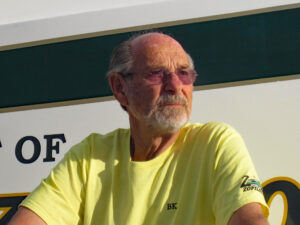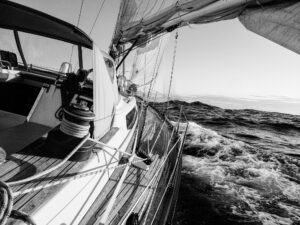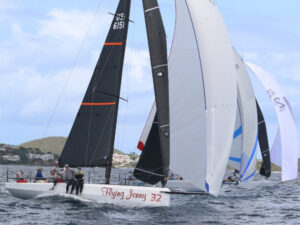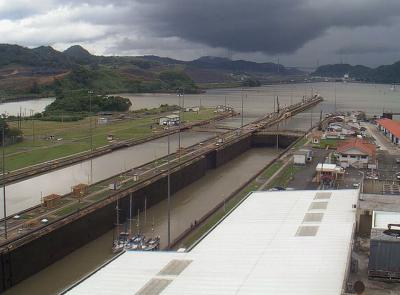
Each time I’ve transited the Panama Canal (as I write this, I’m completing my third), I’ve carefully studied the waves of first the Caribbean Sea and then the Pacific Ocean. They are slightly, but distinctly, different.
Perhaps it’s the increased salinity of the Pacific. (Once, I pulled into New Zealand after a severe gale with stanchions that looked like they had snow caked on one side, thanks to all the encrusted salt.) As a sailor, I first picked up on a subtle wave variation between oceans in Japanese art prints. The waves in the pictures always looked slightly off to my East Coast-America eye. Now I realize it’s because they were Northern Pacific waves: slightly mistier, sharper and more jagged.
I suppose all of us are intrigued with the neighborhoods we grow up in, and I grew up in Oceanus. As an adult, I divide up my watery world into three smaller, more definable ’hoods: the Atlantic, Pacific and Indian oceans.
The Atlantic is, for me, the most illustrious. It is incredibly rich in maritime traditions. It’s the home of nearly all my childhood sailing heroes. Mystic Seaport in Connecticut is the closest this sailor ever gets to a land-church. Ah, the shipwrights of Maine, Cape Cod and City Island. There’s Minot’s Ledge Light and its blinking message of love (1, 4, 3: I love you); Boston Harbor; Throggs Neck; Marblehead and New Bedford and its wheeling seagulls; the skipjacks of the Chesapeake; Cape Hatteras; Joshua Slocum; John G. Alden; Nathaniel Herreshoff; Olin Stephens.
It was in the Atlantic that Howard Blackburn, a humble Gloucester cod fisherman, left most of his fingers frozen to his dory oars years before he started singlehanding across the Pond in an engineless, gaff-rigged craft of modest dimensions.
Landlubbers ponder the Mystery of the Bermuda Triangle, when, of course, there’s no mystery there whatsoever to an offshore sailor. It’s the most heavily traveled body of water and has a major ocean current, the Gulf Stream, which is regularly opposed by gale-force winds. (With one hand you can count the times I’ve been scared in 53 years of ocean sailing: two have been in that same Gulf Stream and one occurred where the Indian South Equatorial and Agulhas currents collide off the north tip of Madagascar).
Why the Atlantic is still considered the graveyard of ships is because it was the civilized world’s ocean crossroads for so many adventurous decades. The Atlantic is relatively small as Earth’s oceans go, but it packs a lot of action into its confined space. The south Atlantic is amazingly benign and almost totally hurricane free. Harborless St. Helena is my favorite island between South Africa and South America. It’s a watery, wave-tossed community that is still obsessed with Napoleon Bonaparte, as if he’d died just yesterday. If you have to cross an ocean in an Optimist pram, make sure it’s the South Atlantic — you can even use a candle as a compass light.
It’s the North Atlantic that captures all the attention. The passage through the cut into the harbor at St. George’s Island, Bermuda, is a voyage-weary sailor’s moment to be cherished forever. It’s akin to pulling into the Azores or the Canaries after a full ocean’s crossing.
The unique feature of the Atlantic is the Bermuda High, which sits fairly stationary in the middle of the sea during the summer months, spinning like a clock. It plays a large part in all Atlantic weather, particularly the Caribbean trade winds and the Gulf Stream.
Far, far before the time of Columbus, ocean navigators knew this, and that’s why they told the Admiral of the Ocean Sea to head south to the Canaries before attempting to cross westward to the West Indies, which, of course, weren’t the Indies at all. “Leave low, return high,” is still the mantra of European cruisers taking off a year to sail the Caribbean and East Coast of America, with the prevailing winds and currents astern the entire time.
Directly south of the Bermuda High is an area of calms still known as the Horse Latitudes. Horses are thirsty creatures. According to lore, if a west-bound transport ship cut the corner of the Bermuda High too closely, they’d be becalmed. The men would immediately be put on half water rations, so the parched cargo would survive. But if the horses began to die, the remaining ones would have to be run off the deck by the weak, weary crew. Horses can swim for a long time. Horses can suffer for a long time. They can also scream and whinny and foam at the mouth for a long, long time. Even worse, they’d try to clamber back aboard, hoofs frantically clawing on the hot, swelling, sun-bleached topsides. Meanwhile, the ships were unable to sail away for want of breeze. It was madness, pure madness, which caused more than one ol’ salt to slip his hawser and go insane.
As a circumnavigator, I have tremendous respect for the Atlantic. Her weather is fickle. Rocks abound. Currents rip. Sirens lure. You never feel perfectly comfortable there, not like in the Pacific. But the Atlantic is a great teacher. If you learn her often cruel lessons, the rest of the world is smooth sailing by comparison.
The Pacific strikes me as far more benign. Yes, its distances are vast, but its weather is usually stable. The giant waves the surfers ride in Hawai‘i are mere wave trains when encountered by an experienced Polynesian navigator, known as a wayfinder.
I think of the Pacific as home to the Mythical Isles because the Polynesian gods will nonchalantly chat with you in Fatu Hiva and Bora-Bora.
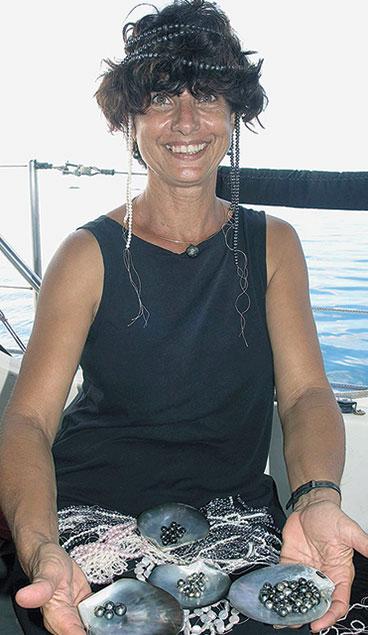
The Polynesians are utterly beautiful and naturally sensuous; even the manliest of the men are beautiful beyond belief. Gauguin captured the colors and the eroticism of these sun-drenched isles perfectly. It’s easy to be bewitched here. I have been smitten many times and still am, I guess.
On one voyage through the Pacific, we were adopted by the entire village of Kauehi, in the Tuamotus. We could take any fish in the lagoon and pick any fruit from the trees. What more could any man ask for? Heaven, for me, is wandering the Tuamotus with neither clock nor calendar. This is where my sailing family set off for in the mid 1950s, and it remains our personal, private rendition of Homer’s Ithaca.
In a sense, my whole life has been spent either sailing the Pacific or preparing to. The vast distances between islands intimidate some sailors — in the Caribbean, most of the isles have 40 or so miles between them; 1,000-plus isn’t unusual in the vast, vast Pacific. But I don’t view the distances that way. To me, the islands aren’t far apart; rather, the dangers are few. It’s the land I fear, not the sea.
But the best I’ve saved for last: The Indian Ocean is my favorite big body of water. It offers a myriad of advantages, at least to this sailor’s eye.
First, it blows down south. If you want full-on sailing with high winds and big seas, head there because the Roaring Forties truly roar. You’re completely on your own too. There is no nitpicking Nanny State a-tall.
Secondly, it’s culturally incredibly varied. Think Australia, Indonesia, Malaysia, Thailand, India, the Mideast, Chagos, Madagascar and Africa. There is no superpower lining its shores. There’s an advantage to not having a bully in the neighborhood.
In the Atlantic, you sail from civilization to civilization. In the Pacific, world cruisers still sort of “hold hands” on their way to New Zealand. Only in the Indian Ocean is it every man-jack for himself. To the north of the equator across the Indian Ocean, the wind is monsoonal. Imagine the Caribbean trade winds reversing direction every six months and you’ve got the picture. This means you can get from anywhere (say, Chagos) to anywhere east or west (say, Malaysia or Africa) by sailing dead downwind if you’re patient and wait for the monsoonal shift. Or shift hemispheres to pick up an opposite breeze. Patience is, of course, a sailor’s virtue. Cruising is as much attitude as skill. The power boater wants to go when he’s ready; the sailor, when the conditions allow. That’s why, even while sharing the same ocean, we’re philosophically worlds apart.
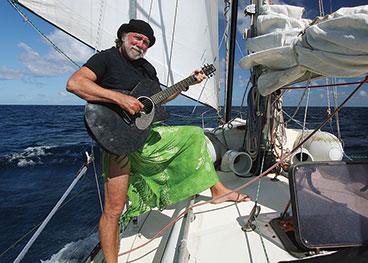
Once upon a time, I sailed Lake Michigan. Ultimately, I knew it like the back of my own hand. Ditto, the Caribbean. It’s fun to sail in home waters, where the charts are etched forever in your head. But now, as we sit in Panama, waiting to strike off across the vast Pacific and with the Indian Ocean still farther beyond, I feel that I’m living my destiny, sailing my dream, ocean mile by ocean mile.
Even as a child, I didn’t want to be a policeman or fireman or park ranger; I wanted to be a sailor. Now we are on the Balboa side of the Panama Canal, idly observing the waves. My arm is around my wife, Carolyn. The air smells like cotton candy. The sky above and the ocean that’s calling are both bluer than blue. We sit poised on the tip of another great adventure. The horizon calls, the entire world beckons, but phrases fail.
“What’s next?” asks my wife, lover and fellow sailor of 43 blissful years.
“Some sailing?” I ask.
She thinks about it, pauses, and smiles as she considers the next year or two. “I could use more pearls,” she admits.
“The Tuamotus,” I say, “are but a broad reach away.”
“And some of that flowered fabric in Papeete.”
“We’ll chill out in Moorea for a while too,” I agree, “and check out the mantas of Bora-Bora.”
“It would be great if this time we could finally afford one of those carved paddles from that fishing village just south of Nuku‘alofa.”
“Sure.” I smile. “Tonga, Fiji and Vanuatu are all on the list.”
“As much as I don’t want to retrace any of our steps,” she muses.
“You’d love to go back to Borneo, Southeast Asia, Chagos and Madagascar, right?”
“Exactly,” she says, and giggles. “Westward!”
“Westward ho!” I agree.
Fatty and Carolyn, aboard their Wauquiez 43, Ganesh, are bound for French Polynesia, one landfall at a time. Click here to read more from Cap’n Fatty.

